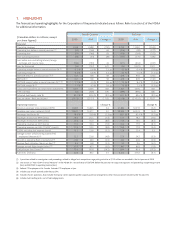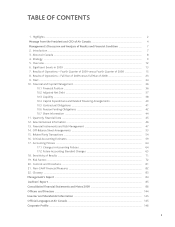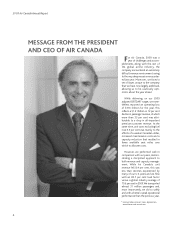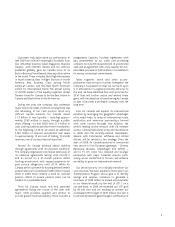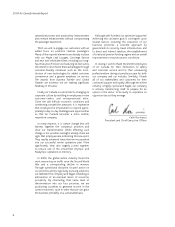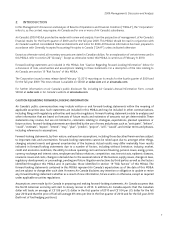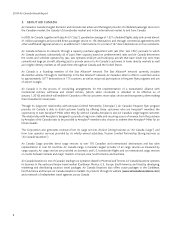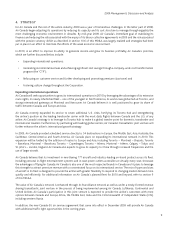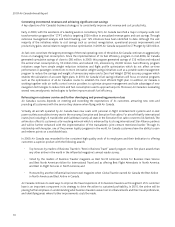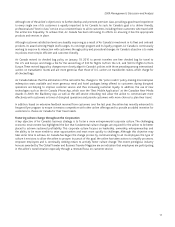Air Canada 2009 Annual Report Download - page 10
Download and view the complete annual report
Please find page 10 of the 2009 Air Canada annual report below. You can navigate through the pages in the report by either clicking on the pages listed below, or by using the keyword search tool below to find specific information within the annual report.2009 Air Canada Annual Report
10
Generating incremental revenues and achieving signifi cant cost savings
A key objective of Air Canada’s business strategy is to consistently improve unit revenue and cost productivity.
Early in 2009, with the assistance of a leading aviation consultancy fi rm, Air Canada launched a major company-wide cost
transformation program (the “CTP”) which is targeting $500 million in annualized revenue gains and cost savings. Through
extensive management analysis and benchmarking, over 125 initiatives have been identifi ed to date. Although the vast
majority of the initiatives relate to cost savings such as contract renegotiation, operational process improvements and
productivity gains, several relate to target revenue optimization. In 2009, Air Canada surpassed its CTP target by $20 million.
As fuel costs constitute the largest percentage of the total operating costs of the airline, Air Canada continues to aggressively
focus on managing fuel consumption. Since the implementation of its fuel effi ciency program in mid-2006, Air Canada
generated cumulative savings of close to $80 million. In 2009, this program generated savings of $12 million and reduced
the airline’s fuel consumption by 18 million litres, and reduced CO2 emissions by 45,000 tonnes. Fuel effi ciency program
initiatives range from simple weight reduction initiatives and fl ight profi le optimization which do not affect on-time
performance or passenger connections to more innovative weight savings initiatives such as a potable water management
program to reduce the carriage and weight of unnecessary water and a Zero Fuel Weight (ZFW) accuracy program which
enables the calculation of accurate fl ight plans. In 2010, Air Canada’s fuel saving initiatives will focus on several programs
such as the optimization of all Air Canada’s routes to establish the most effi cient fl ight plan. In addition, Air Canada is
working together with air traffi c control service providers to optimize airspace management and take advantage of new
navigation technologies to reduce time and fuel consumption used to approach airports. Moreover, Air Canada is evaluating
several new aerodynamic technologies to further improve aircraft fuel effi ciency.
Refocusing on customer service and further developing and promoting premium class
Air Canada’s success depends on meeting and exceeding the expectations of its customers, attracting new ones and
providing all customers with the service they deserve when fl ying with Air Canada.
Virtually all aircraft operated by Air Canada have new seats with personal in-fl ight entertainment systems and in-seat
power outlets accessible at every seat in the economy, Executive and Executive First cabins. For aircraft that fl y international
routes (not including U.S. transborder and Caribbean routes), all seats in the Executive First cabin convert to lie-fl at beds. The
airline also offers its customers a far-reaching network which is enhanced by its strong international Star Alliance partners
and will be further enhanced with the implementation of the transatlantic joint venture mentioned earlier. Through its
relationship with Aeroplan, one of the premier loyalty programs in the world, Air Canada customers have the ability to earn
and redeem points on a worldwide basis.
In 2009, Air Canada was rewarded for the consistent high quality work of its employees and their dedication to offering
customers a superior product with the following awards:
• Top honours by readers of Business Traveler’s “Best in Business Travel” award program, more fi rst place awards than
any other airline in the world in the infl uential magazine’s annual reader survey;
• Voted by the readers of Business Traveler magazine as Best North American Airline for Business Class Service
and Best North American Airline for International Travel and as offering Best Flight Attendants in North America;
and Best In-Flight Services in North America; and
• Honoured by another infl uential business travel magazine when Global Traveler named Air Canada the Best Airline
in North America and Best Airline in Canada.
Air Canada continues to seek ways to improve the travel experience of its business travelers as this segment of its customer
base is an important component in its strategy to drive the airline to sustained profi tability. In 2010, the airline will be
placing further emphasis on understanding what business travelers value most in enhancements and their travel preferences,
and identifying areas where further improvements could be made.


